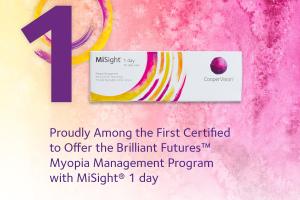by Tiffany Yanase, OD

Many children may not be able to describe what they see, or discern what is considered normal vision. The American Academy of Pediatrics, the American Academy of Ophthalmology, and the American Optometric Association recommend regular eye examinations for children, starting as early as in infancy.1-3 Vision screenings can flag concerns for abnormal vision development, and a comprehensive eye exam can formally evaluate a child’s vision, eye teaming, and eye health. As part of a child’s care team, an optometrist can help parents understand their child’s eyes. While this can be touched on at a pediatrician well child check-up, optometrists are well positioned to delve deeper into discussions about vision milestones and to mitigate risks for future vision problems.
As children experience rapid changes in physical growth and development in their early years, their eyes also undergo dramatic changes.
Eye exams beginning before age 1 and continuing at regular intervals can start a fluid conversation with parents about eye wellness and the visual system.
Months 6 to 12
Full-term babies have basic eye screenings before 6 months of age and before 12 months of age in a primary care setting. AOA Foundation’s InfantSEE program offers a comprehensive eye exam by optometrists to infants between the ages of 6 and 12 months at no-charge to the family.4 The InfantSEE exam is a great introduction to the early timeline of vision development. Babies become curious of their surroundings and are beginning to crawl and walk. Perhaps more noteably, parents themselves are curious about what the baby can actually see. (In short, even a normal baby does not see 20/20 yet!) During the first year of life, there are incredible changes with accommodation, refractive error, eye motility, and stereopsis.5 It is well-documented that infants are expected to be hyperopic, in the ballpark of 2.00 diopters. Concerns including pseudostrabismus and nasal lacrimal duct obstructions often manifest at this age. Other less apparent but vision-threatening disease can be detected, and can also be indicators of general health problems.6 A baby’s first eye visit establishes the first point in a dynamic process of vision development. The following years will begin to reveal how vision may trend during youth.
Years 1 to 3
After congenital conditions and gross amblyogenic risks are ruled out at the first visit, the eye exam performed before age 3 hones in on refractive development and eye alignment. The deceleration of considerable refractive error changes begins around age 2 and can stretch out to age 3.7-9 The duration and dynamics of this process can vary in each child, but an optometrist can obtain a more representative picture of where refractive errors may land. The concept of emmetropization can help answer the common questions by parents of “will my child grow out of a prescription” and “will my child need to wear glasses forever”.
The growing eye taps into feedback cycles to focus incoming light accurately onto the retina. Studies about emmetropization in human subjects show substantial changes in axial growth which affects resultant refractive error. 7 Hyperopia and astigmatism linearly decrease toward a low hyperopic level relative to the starting point.8,9 Even early myopia can regress towards low hyperopia.9 This ideal trend to bring the eyes near spherical emmetropia occurs naturally, but can be altered by other factors. The exact interactions between genetics, the visual experience, and pre-programmed emmetropia is still being investigated.
Significant refractive errors do not follow the same pattern of emmetropization and are likely to persist.10 When left uncorrected, amblyopia and, in some cases, strabismus can result and in turn disrupt vision development.11 Glasses for amblyopia should be regarded as a treatment requiring firm compliance, especially given that cortical plasticity is high at this age.
Year 5
It is staggering that currently only two states in the United States require a comprehensive eye examination before a child enters school. A failed vision screening at school or at the pediatrician’s office should not be the only impetus for a full eye examination.12 It is important to check back in with kindergarten children to assess the status of their visual systems. Ideally, this would be a continuation of the care they have already received from their optometrist. Visual demands would have changed as children are likely transitioning to a formal classroom setting. Vision is reliably quantified at this age by matching or recognizing optotypes13, and 5-year-old children should be seeing 20/40 or better in the absence of amblyopia.14
So, if children are not in glasses already at this point, are they in the clear? Recent data shows the prevalence of myopia at age 5 at less than 7%, but up to one-third of fifth graders have myopia.15 Research has revealed that the fastest rate of change can be in the year before myopia onset16, so this 5-year-old exam can be capturing children before the eyes deviate away from hyperopia or emmetropia. The inevitable question from parents are “will my child need glasses?” or “how can I prevent my child from needing glasses?” Though there is no crystal ball, many studies have shed light on the genetic contribution of refractive error and how outdoor play can curb this trend.
The high correlation of refractive errors within families cannot be ignored, as myopia has high heritability between siblings and parents.17,18 The risk of myopia in a child increases with the number of myopic parents.18 However, a proactive recommendation that all parents can heed to is to increase time outdoors.19,20 Increased time per week playing sports and being outdoors can decrease risk of myopia even for children with two myopic parents.19 This is the prime time to have conversations with parents about outdoor time, because less than 0.75 diopters of hyperopia at age 6 is associated with an increased risk for developing myopia.21 The effect of outdoor time is more protective among children who were not yet myopic20, so this discussion is critical to preserve the hyperopic buffer.
A common and justified concern by parents is the change in how much time children are now spending on screens. There is mixed evidence on their relationship to myopia. A large systemic review have suggested more time spent with near activities is highly linked with myopia22, while another shows that it is not.23 Considering other aspects of a child’s development, less time using tablets and phones can be a good idea for overall social development and attention.24 The American Academy of Pediatrics recommends limitations of up to one hour of high-quality programming for children at this age.25 As part of the care team, optometrists can support messaging that children engage in their homes and environment to promote development of healthy eyes and minds.
An optometrist who works with the pediatric population has the privilege of shaping a child’s perspective on early life. Vision has far-reaching implications on learning and social development. Management should begin in infancy to journey with parents in navigating risk factors and tracking vision development. Visits in early school-aged years will eventually zoom out towards long-term care. Together with parents, optometrists share the responsibility of intervening on a child’s vision trajectory.
________________________________________

Dr. Tiffany Yanase Park graduated magna cum laude from Southern California College of Optometry and completed a pediatric optometry residency at Children’s Hospital Colorado. Dr. Yanase Park now works as part of a university-based pediatric ophthalmology department in Southern California.
References
American Academy of Pediatrics. Eye Examination in Infants, Children, and Young Adults by Pediatricians. Pediatrics. 2003 Apr;111(4 Pt 1):902-7.
American Academy of Ophthalmology. AAO Pediatric Ophthalmology/Strabismus Panel. Preferred Practice Pattern Guidelines: Pediatric Eye Evaluations. 2017.
American Academy of Optometry. Evidence-Based clinical practice guidelines: Comprehensive Pediatric Eye and Vision Examination. 2017.
American Academy of Optometry, Optometry Cares – The AOA Foundation. InfantSEE program. https://infantsee.org
Candy TR. The Importance of the Interaction Between Ocular Motor Function and Vision During Human Infancy. Annu Rev Vis Sci. 2019 Sep 15; 5: 201–221.
Macdonald IM, Mah DY. Summary of heritable ocular disorders and selected systemic conditions with eye findings. Ophthalmic Genet. 2000 Mar;21(1):29-49.
Mutti D et al. Axial growth and changes in lenticular and corneal power during emmetropization in infants. Invest Ophthalmol Vis Sci. 2005 Sep;46(9):3074-80
Atkinson J et al. Normal Emmetropization in Infants with Spectacle Correction for Hyperopia. Invest Ophthalmol Vis Sci. 2000 Nov;41(12):3726-31.
Ehrlich DL et al. Reduction of infant myopia: a longitudinal cycloplegic study. Vision Res. 1995 May;35(9):1313-24.
Ehrlich DL et al. Infant emmetropization: Longitudinal changes in refraction components from nine to twenty months of age. Optom Vis Sci. 1997 Oct;74(10):822-43.
Pascual M et al. Risk factors for amblyopia in the vision in preschoolers study. Ophthalmology. 2014 Mar;121(3):622-9.e1.
National Center for Children’s Vision and Eye Health at Prevent Blindness. 2020. Children’s Vision and Eye Health: A Snapshot of Current National Issues (2nd ed.) Chicago, IL: National Center for Children’s Vision and Eye Health at Prevent Blindness.
Leone JF et al. Visual acuity testability and comparability in Australian preschool children: The Sydney Paediatric Eye Disease Study. Eye (Lond). 2012 Jul;26(7):925-32.
MEPEDS Group. Visual Acuity Norms in Pre-School Children: The Multi-Ethnic Pediatric Eye Disease Study. Optom Vis Sci. 2009 Jun;86(6):607-12
Rudnicka AR et al. Global variations and time trends in the prevalence of childhood myopia, a systematic review and quantitative meta-analysis: implications for aetiology and early prevention. Br J Ophthalmol. 2016 Jul;100(7):882-890.
Mutti D et al. Refractive error, axial length, and relative peripheral refractive error before and after the onset of myopia. Invest Ophthalmol Vis Sci. 2007 Jun;48(6):2510-9.
Jones-Jordan LA et al. The contributions of near work and outdoor activity to the correlation between siblings in the Collaborative Longitudinal Evaluation of Ethnicity and Refractive Error (CLEERE) Study. Invest Ophthalmol Vis Sci. 2014 Sep 9;55(10):6333-9.
Jones-Jordan LA et al. Early childhood refractive error and parental history of myopia as predictors of myopia. Invest Ophthalmol Vis Sci. 2010 Jan;51(1):115-21.
Jones LA et al. Parental history of myopia, sports and outdoor activities, and future myopia. Invest Ophthalmol Vis Sci. 2007 Aug;48(8):3524-32.
Xiong S et al. Time spent in outdoor activities in relation to myopia prevention and control: a meta-analysis and systematic review. Acta Ophthalmol. 2017 Sep;95(6):551-566.
Zadnik K et al. Prediction of Juvenile-Onset Myopia. JAMA Ophthalmol. 2015 Jun;133(6):683-9.
Huang HM, Chang DST, Wu PC. The Association between Near Work Activities and Myopia in Children – A Systematic Review and Meta-Analysis. PLoS One. 2015 Oct 20;10(10):e0140419.
Lanca C, Saw SM. The association between digital screen time and myopia: A systematic review. Ophthalmic Physiol Opt. 2020 Mar;40(2):216-229.
Radesky JS, Christakis DA. Increased Screen Time: Implications for Early Childhood Development and Behavior. Pediatr Clin North Am. 2016 Oct;63(5):827-39.
American Academy of Pediatrics Council on Communications and Media. Media and Young Minds. Pediatrics. 2016 Nov;138(5).








